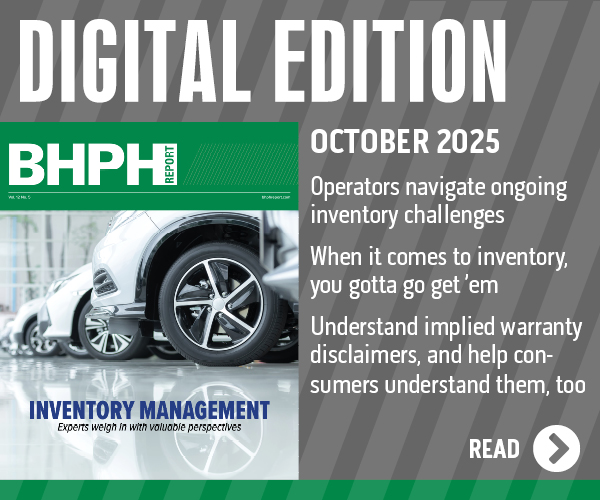Holman: How to handle customers not pushing ‘industry disruption’

By subscribing, you agree to receive communications from Auto Remarketing and our partners in accordance with our Privacy Policy. We may share your information with select partners and sponsors who may contact you about their products and services. You may unsubscribe at any time.
OKLAHOMA CITY –
For the last couple of years, the buzz word of the automobile industry has been “disruption.” Granted, our industry may not have the exclusive on disruption, but it has most definitely been disrupted.
They say, that is the proverbial “they,” that the root cause of all this disruption is technology. And, I imagine as you read this, you have certainly seen changes in your operation to accommodate all the changes technology has brought to the shopping process, the buying process, the financing process and even how we dealers acquire inventory. I say this not because I take issue, quite the contrary, I have seen it. I have utilized it. I have embraced it.
We have all been disrupted and, as I have said in a previous article, a dealer who is hanging on to a business model whose age is measured in decades rather than months or a year or two, is having trouble keeping up. His drive-by traffic has decreased, his advertising initiative is no longer driving traffic, sales volume has decreased and, most likely, he has seen that equate to compressed margins. Which is fancy way to say, “He ain’t making the money he used to.”
OK, so this is kind of last year’s subject matter and it’s getting a bit tiresome to keep seeing the same heads up, beware of the disruptions in article after article. No wonder dealers are saying, “Tell me something I don’t know.” The disruptions aren’t going away. The industry has, is and will continue to change.
In the midst of all these changes, an unintentional by-product seems to have been identified. A niche, when targeted by dealers, is working quite unexpectedly well for a few of my dealer clients. And, what is it you ask?
The answer is both simple and right under our noses. Before there is tomorrow, there is today. OK, before you chastise me too quickly for stating the obvious, let me explain.
Subscribe to Auto Remarketing to stay informed and stay ahead.
By subscribing, you agree to receive communications from Auto Remarketing and our partners in accordance with our Privacy Policy. We may share your information with select partners and sponsors who may contact you about their products and services. You may unsubscribe at any time.
Whether we like it or not, agree with it or not, our customers still drive the marketplace. And, to that avail, there seems to be a few dealers who have discovered that, in spite of the disruptions put upon the industry by technology, some of their customers aren’t jumping on the bandwagon to buy and/or arrange financing for their next automobile utilizing technology.
Think of it this way, a vehicle has several hundred sensors to tell the driver if the seat belt is buckled, the direction the vehicle is travelling, the street it is travelling on, if the speed limit is being exceeded, when the oil is low (Dipsticks are passé. Really, they’re actually making cars that don’t have dipsticks?) And many other engine functions, too. You get the picture.
But what technology hasn’t figured out, at least not yet anyway, is if the dog sitting in the front passenger seat of this technology-packed vehicle will bite. Technology is advancing and will continue to advance, no question about that. And even scarier, that advancement will accelerate. But, humans, or some humans, aren’t adapting to all the changes in technology at the rate they are changing. They are being left behind. And in some cases, some of those are our customers.
So we need to evaluate how or if our customers, as technology keeps moving, and doing so at a faster pace, are keeping up. Also, drill down on how this effects how, when and where they buy their next car(s). Customers still need a car and someone willing to loan s/he the money to buy it. Could it be, as technology defines a new normal customer profile for the industry, generally, it does not for a niche specifically? That is a niche made up of those who have not or cannot adapt to technology and are left out.
Customers essentially have the same basic personal transportation needs that our industry has attempted to meet since Henry Ford began marketing the automobile to the masses. We encourage every dealer to look at his/her business model, beyond which DMS, CRM and inventory procurement system(s) that we spend so much time evaluating and evaluate, not only what disruptions that have occurred, but how your customer base has adjusted.
Some dealers have found their customers have not adjusted at all. They are not keeping up with all the disruptions technology has brought about. These have rethought and readjusted their models so as to target those who could easily be, and often are, forgotten. They have realized a certain niche of their customer base will need more time to adapt to what technology is changing.
In the meantime, by paying close attention to those customer needs, capabilities and challenges, you create a platform that will give them a chance to buy their personal transportation in a method that, albeit behind the disruption curve, works best for them. They realize that this won’t last forever and is not some covert effort to hang onto old-school, outdated ways, but have a product for that niche.
Yes, eventually those customers will catch up and adapt to a new normal. But until that happens, there is still a place that will cater to him/her. Those dealers have realized that one size doesn’t fit all. They have targeted the forgotten and left behind.
Or as we like to say, they have boldly decided to “disrupt the disruption.”
Jim Holman is the operator of Strategic Automotive Consulting and can be reached at (405) 833-7518 or [email protected].


